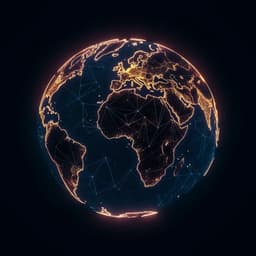
Earth Sciences
India-Asia collision as a driver of atmospheric CO₂ in the Cenozoic
Z. Guo, M. Wilson, et al.
This groundbreaking research conducted by Zhengfu Guo, Marjorie Wilson, Donald B. Dingwell, and Jiaqi Liu analyzes the complex interactions between magmatism and atmospheric CO₂ variations during the Cenozoic era, unveiling the significant role of the India-Asia collision as a primary driver of these changes.
~3 min • Beginner • English
Introduction
The study addresses the long-standing question of what drove the major variations in atmospheric CO₂ and associated climate cooling over the Cenozoic. Two leading hypotheses invoke (1) enhanced CO₂ consumption via silicate weathering linked to uplift of the Tibetan Plateau, and (2) decreased CO₂ release from Earth’s interior due to the shutdown of Neo-Tethyan subduction-related decarbonation during India-Asia collision. Given that both hypotheses ultimately implicate the India-Asia collision, the authors aim to elucidate how collision-related deep carbon cycle processes (magmatism and metamorphism) in Tibet may have controlled atmospheric CO₂. By integrating geochemical, isotopic and geochronological data from Cenozoic Tibetan magmatic rocks with a forward model of collision-derived CO₂ fluxes, they test whether temporal patterns of Tibetan outgassing can causally explain the observed three-stage CO₂ history of the Cenozoic.
Literature Review
Prior work links Cenozoic climate cooling to declining atmospheric CO₂ and debates its controls. Uplift-driven silicate weathering has been proposed to draw down CO₂ (e.g., Raymo & Ruddiman; Misra & Froelich), while others emphasize waning volcanic degassing as the Neo-Tethyan arc shut down during India-Asia collision (Kent & Muttoni; Sternai et al.). Studies suggest Tibetan magmatism/metamorphism record collision evolution and can significantly outgas CO₂ on Myr scales. Enhanced early Cenozoic volcanic CO₂ from carbonate-rich subduction beneath the Tethyan margin has been linked to the EECO. Metamorphic decarbonation along the Himalaya has been argued to be climatically significant, but its time-integrated flux remains uncertain. Global assessments of arc volcanism (Pacific and Neo-Tethyan) have been proposed as primary CO₂ drivers, yet constant oceanic subduction fluxes alone cannot reproduce observed three-stage CO₂ patterns. These strands motivate a Tibet-focused, quantitative, time-continuous reconstruction of magmatic and metamorphic CO₂ outgassing across the Cenozoic.
Methodology
The authors develop a Continental Collision-derived CO₂ Flux Model (CCFM) to quantify magmatic and metamorphic CO₂ emissions from Tibet over the past ~65 Ma. Data inputs comprise new geochemical analyses on 56 primitive samples plus published data from 231 samples, spanning 55 volcanic fields across Tibet (287 samples total), with geochronology curated to exclude low-quality ages. For each volcanic field, mean eruptive ages (and SD) are computed assuming normal distributions to construct a near-continuous Cenozoic time series.
- Source characterization: Sr-Nd-Pb isotopic ratios for magmatic rocks are plotted in mixing space to infer three-component mantle source mixtures comprising DMM, subducted carbonate, and subducted silicate (GLOSS and continental components). End-member compositions are compiled (Table 2). Three-component mixing is implemented via sequential two-component radiogenic isotope mixing equations to estimate proportions of carbonate (A_c) and silicate (A_s) components in each source.
- Partial melting and residue: Trace element non-modal batch melting modeling determines degrees of partial melting (ϕ) and residual mineral proportions (X_i) in the source. Parameter ranges reflect metasomatized mantle including hydrous/volatile-bearing phases (e.g., phlogopite, amphibole, apatite). Best fits to observed trace element concentrations yield final ϕ and X_i for each volcanic field.
- Recycling efficiency and magmatic CO₂ flux: Recycling efficiency f of subducted carbonate is defined as f = ϕ/(A_c + A_s), converting three-component source proportions to the two-component (carbonate+silicate) subducted slab system. Magmatic CO₂ degassing rate u_m is computed following Jagoutz et al. using slab geometry (thickness γ_i, trench-parallel width δ_i), India-Asia convergence rate μ_i, density ρ_i, and f.
- Metamorphic CO₂ flux (Stage 2a only, 55–50 Ma): Isotopes indicate a plume–wedge interaction that reactivates a pre-existing carbonate reservoir in the mantle wedge. Metamorphic CO₂ production is modeled via carbonate dissolution reaction (CaCO₃ + 2H+ → Ca²+ + H₂O + CO₂), distinct from classic decarbonation. The H+ supply is parameterized using water-bearing residual minerals (X_i). A transfer coefficient d = [CO₂]/(2[H+]) links H+ flux to CO₂ flux. The mass flow rate S of H+-rich material in a carbonated mantle plume (CMP) upwelling is estimated from slab geometry and upwelling rate ω_i; metamorphic CO₂ flux m = S × d.
- Total flux and uncertainties: Total collision-derived flux per volcanic field is u_m + m, assembled along the time series defined by mean ages. Uncertainties are propagated from input parameter SDs; smoothed mean curves are presented for clarity. Analytical methods for major/trace elements and Sr-Nd-Pb isotopes follow established protocols with precision/accuracy controls.
Key Findings
- Three-stage Tibetan magmatism aligns with three-stage atmospheric CO₂ history: Stage 1 (65–55 Ma) Neo-Tethyan oceanic subduction; Stage 2 (55–25 Ma) Indian continental subduction with mantle transition zone-derived carbonated plume (CMP) upwelling; Stage 3 (25–0 Ma) dual India–Asia continental underthrusting.
- Atmospheric CO₂ stages and modeled fluxes:
• Stage 1: Atmospheric CO₂ ~400–450 ppm; modeled collision-related CO₂ flux low (0.0002–0.0035 Pg/yr). Source contains low carbonate component (0.018–0.080%), high melting (6.50–13.00%), recycling efficiency 0.06–1.21%.
• Stage 2: Atmospheric CO₂ high (~900 ppm); modeled flux high (0.0838–6.7206 Pg/yr) with peak ~7 Pg/yr near 52 Ma. Source has high carbonate proportions (0.026–0.966%), intermediate melting (3.90–17.25%), recycling efficiency 0.03–4.79%. Subdivision:
- Stage 2(a) 55–50 Ma: Abrupt jump in outgassing; metamorphic dissolution of a deep carbonate reservoir in the wedge contributes up to ~4.4 Pg/yr and can be an order of magnitude larger than magmatic flux. Plume–wedge interaction (CMP with GLOSS-modified wedge) drives large magmatic and metamorphic emissions.
- Stage 2(b) 50–25 Ma: Declining flux consistent with waning magmatism along the southern Eurasian margin; metamorphic contribution wanes as deep reservoir is exhausted; magmatism dominates.
• Stage 3: Atmospheric CO₂ low (~300 ppm); modeled flux intermediate (0.0031–0.0348 Pg/yr) with small variations. Source shifts to silicate-rich inputs from India and Asia; low degrees of melting (0.32–4.23%); recycling efficiency 0.01–0.23%.
- Present-day Tibetan diffuse degassing (hot springs, faults, soil microseepage) is ~15 Mt/yr, agreeing with CCFM estimates of ~17–20 Mt/yr.
- India–Asia collision-derived CO₂ flux in Stage 2 exceeds oceanic subduction arc fluxes (Neo-Tethyan Stage 1 and Pacific) by up to two orders of magnitude, explaining the Cenozoic high-CO₂ interval.
- Two stepwise transformations inferred: at ~55 Ma (mechanism shift from arc magmatic degassing to collision-related magmatic plus metamorphic outgassing) and at ~25 Ma (carbon reservoir shift from carbonate-platform to silicate-rich continental inputs).
Discussion
The modeled CO₂ outgassing history tightly correlates with the global atmospheric CO₂ curve, supporting a causal link that the India–Asia collision was the primary driver of Cenozoic CO₂ variations. Stage 1 oceanic subduction produced modest CO₂, yielding intermediate atmospheric CO₂. Stage 2 Indian continental subduction introduced abundant carbonate, producing large magmatic and metamorphic emissions (especially 55–50 Ma via carbonate dissolution), accounting for the EECO-high CO₂ state and subsequent decline as magmatism waned after ~50 Ma. Stage 3 dual continental underthrusting with silicate-rich inputs and reduced melting yielded lower fluxes consistent with low atmospheric CO₂ and icehouse conditions. The findings distinguish collision-derived degassing from oceanic arc degassing, explaining why constant Pacific arc fluxes cannot reproduce the observed three-stage atmospheric CO₂ evolution. Mechanistically, Stage 2 involves plume–wedge interaction and reactivation/exhaustion of a deep carbonate reservoir, whereas Stage 3 reflects diminished carbonate supply. A noted mismatch—low flux in Stage 1 vs intermediate CO₂, and intermediate flux in Stage 3 vs low CO₂—likely reflects variable silicate weathering sinks (possibly enhanced by late Cenozoic uplift), highlighting the net balance between sources and sinks. Overall, the results underscore the central role of collision-related deep carbon processes in pacing Cenozoic climate.
Conclusion
By integrating comprehensive geochemical/isotopic datasets with a forward CCFM, the study quantifies Tibetan collision-derived magmatic and metamorphic CO₂ outgassing over 65 Myr and demonstrates a three-stage flux history that mirrors the Cenozoic atmospheric CO₂ record. It identifies India–Asia collision processes—particularly carbonate-rich subduction and transient metamorphic dissolution during 55–50 Ma—as the dominant drivers of elevated CO₂ in the early–middle Cenozoic, with declining outgassing thereafter. The work delineates two stepwise transitions in degassing mechanisms and carbon reservoirs (at ~55 Ma and ~25 Ma) and reconciles present-day diffuse degassing with model predictions. Future research should quantify net CO₂ budgets by jointly modeling deep degassing and silicate weathering, refine timing/magnitude of Tibetan uplift and weathering feedbacks, and extend the approach to other collisional systems to test global applicability.
Limitations
- The model focuses on Tibetan collision-related outgassing and does not explicitly quantify contemporaneous global silicate weathering sinks, limiting interpretation of net atmospheric CO₂ balance, especially for Stages 1 and 3 where mismatches are noted.
- Timing and magnitude of Tibetan Plateau uplift remain debated, introducing uncertainty into inferred weathering feedbacks.
- CCFM relies on end-member compositions, mixing assumptions, and parameterizations (e.g., slab geometry, convergence and upwelling rates, hydrous mineral proxies for H+) that carry uncertainties; while propagated, they may affect absolute flux magnitudes.
- Metamorphic CO₂ flux is modeled for Stage 2(a) via carbonate dissolution with indirect constraints on the deep carbonate reservoir and H+ supply, which could vary spatially/temporally.
- Oceanic arc contributions are treated broadly; regional variability is not fully resolved.
Related Publications
Explore these studies to deepen your understanding of the subject.







